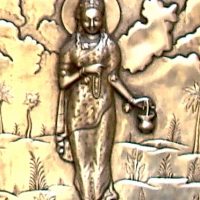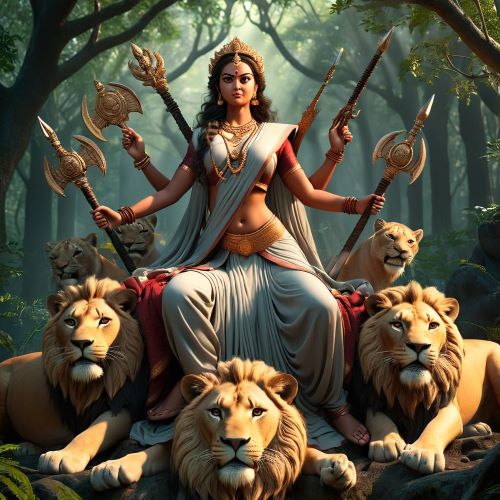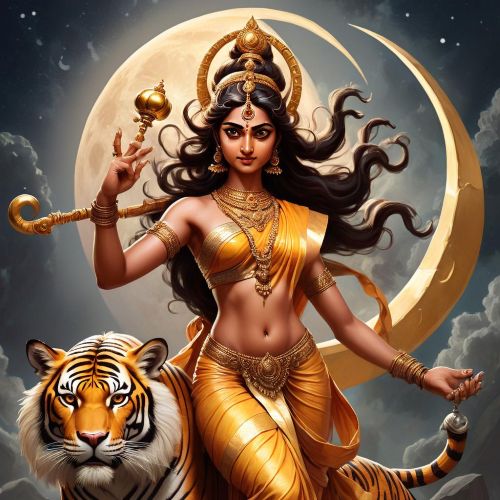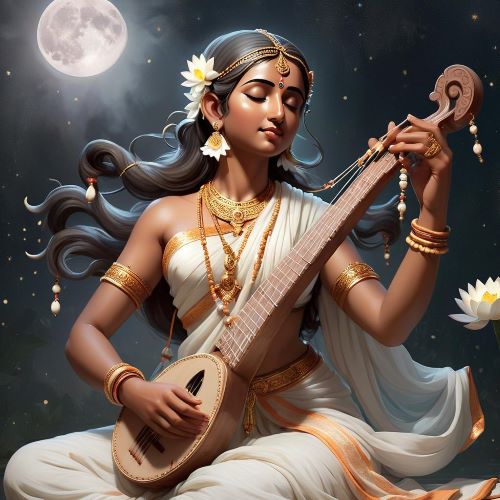Brahmacharini : Goddess of Discipline
Listen
At a glance
| Description | |
|---|---|
| Origin | Indian Mythology |
| Classification | Gods |
| Family Members | Himavan (Father), Maina (Mother) |
| Region | India |
| Associated With | Celibacy, Discipline, Simplicity |
Brahmacharini
Introduction
Brahmacharini (Sanskrit: ब्रह्मचारिणी) is the second form of Navadurga, the nine manifestations of Goddess Durga, honored on the second day of the Navratri festival. The name Brahmacharini is rooted in Brahmacharya, a concept that emphasizes the pursuit of higher knowledge, celibacy, discipline, and self-restraint. In Hindu tradition, she represents the ascetic phase of Goddess Parvati when she renounced worldly comforts and embraced a life of austerity to win the love of Lord Shiva. This aspect of the goddess personifies the ideals of determination, spiritual strength, and the transformative effect of penance. Devotees worship her not only as a deity but also as a symbol of perseverance and inner purity, drawing inspiration from her journey of self-discipline and devotion.
Physical Traits
Brahmacharini is typically depicted in simple yet deeply symbolic iconography. She is portrayed in a spotless white sari, a color that reflects purity, detachment, and unwavering focus on spiritual goals. In her right hand, she carries a japamala or rosary, representing constant meditation and prayer, while her left hand holds a kamandalu or water pot, signifying a life of asceticism and self-sufficiency. Artists often show her walking barefoot, a visual reminder of her renunciation of luxury and comfort. Unlike the more warrior-like forms of Durga, Brahmacharini’s expression is calm, serene, and meditative, radiating the quiet strength that comes from discipline and resilience. Her simplicity in appearance communicates that true power often lies in restraint and inner stillness rather than external grandeur.
Family
As Brahmacharini is an incarnation of Parvati, her divine lineage connects her to some of the most revered figures in Hindu mythology. She is the daughter of King Himavan, the lord of the mountains, and Queen Maina. In her earlier birth, she was Sati, the devoted wife of Shiva, who immolated herself at her father Daksha’s sacrificial ceremony in protest against his insult toward her husband. Reborn as Parvati, she chose to undergo severe austerities to reunite with Shiva. During her Brahmacharini form, she remains unmarried, representing her spiritual journey before her eventual union with him. Later, as Parvati and Shiva together, she became the mother of Ganesha and Kartikeya, but Brahmacharini emphasizes the phase of her life dedicated exclusively to penance and devotion, rather than family life.
Other names
Brahmacharini is revered under various titles that highlight her qualities of penance and devotion. She is often called Tapascharini or Tapasyacharini, both terms underscoring her practice of tapas, or spiritual austerities. Another epithet is Aparna, meaning “the one who does not eat even a leaf,” a reference to her extreme penance in which she abstained from food, even rejecting dry bilva leaves. She is also addressed as Devi Yogini and Devi Tapasvini, acknowledging her commitment to yogic discipline and ascetic life. In the Navadurga tradition, she is remembered simply as the “second form,” marking her place in the sequence of Durga’s manifestations during Navratri. Each of these names captures a facet of her journey, portraying her as a goddess whose strength comes from devotion and endurance.
Powers and Abilities
The powers of Brahmacharini are drawn not from weapons or aggression but from her inner strength and penance. Her ability to endure harsh austerities for thousands of years demonstrates the spiritual endurance she embodies. Through her tapasya, she cultivated a power that could inspire and uplift devotees, granting them clarity of thought and resilience in the face of difficulties. In legend, her kamandalu symbolizes life-sustaining purity, and her presence is believed to dispel negativity and cleanse the mind of distractions. She represents control over the senses, guiding worshippers toward focus and righteousness. Many devotees pray to her for strength to overcome emotional struggles, to develop perseverance, and to achieve mastery over desires. Unlike warrior goddesses who destroy demons with weapons, Brahmacharini teaches that true conquest lies in mastering oneself, an ability considered as powerful as any act of external victory.
Modern Day Influence
In present times, the worship of Brahmacharini continues to play a vital role during Navratri celebrations. On the second day, temples and households across India are adorned in white to honor her purity, and devotees observe rituals of fasting and meditation to invoke her blessings. Beyond religious practice, Brahmacharini’s symbolism has gained contemporary relevance. In a world often defined by distractions and instant gratification, she stands as a reminder of the virtues of patience, discipline, and consistent effort. Spiritual teachers and motivational speakers frequently reference her as an archetype of commitment and focus, making her story resonate even outside religious circles.
Cultural programs, devotional songs, and modern digital art keep her narrative alive, particularly among younger generations seeking connection with traditional values. In recent years, her story has also found expression in online platforms, illustrated texts, and even AI-generated images that help spread her teachings globally. For women especially, Brahmacharini serves as a powerful role model, demonstrating how inner strength and dedication can transform life’s journey. Whether in spiritual practices, educational settings, or personal growth discourses, the essence of Brahmacharini continues to inspire individuals to embrace resilience, pursue wisdom, and live with purposeful self-discipline.
Related Images
Source
Wikipedia contributors. (2025). Brahmacharini. In Wikipedia. Retrieved September 23, 2025, from https://en.wikipedia.org/wiki/Brahmacharini
Indian Mythology Stories. (n.d.). What is the story behind Goddess Brahmacharini?. Retrieved September 23, 2025, from https://indianmythology.co.in/story-behind-goddess-bramhacharini/
Shrimad Bhagvat Geeta. (n.d.). Maa Brahmacharini. Retrieved September 23, 2025, from https://www.shrimadbhagvatam.org/pinned_posts/maa-brahmacharini/
Kinsley, D. (1988). Hindu Goddesses: Visions of the Divine Feminine in the Hindu Religious Tradition. University of California Press.
Coburn, T. B. (1991). Encountering the Goddess: A Translation of the Devi-Mahatmya and a Study of Its Interpretation. SUNY Press.
Bhattacharyya, N. N. (1999). History of the Sakta Religion. Munshiram Manoharlal Publishers.
Foulston, L., & Abbott, S. (2009). Hindu Goddesses: Beliefs and Practices. Sussex Academic Press.
Frequently Asked Questions
What is lorem Ipsum?
I am text block. Click edit button to change this text. Lorem ipsum dolor sit amet, consectetur adipiscing elit. Ut elit tellus, luctus nec ullamcorper mattis, pulvinar dapibus leo.
What is lorem Ipsum?
I am text block. Click edit button to change this text. Lorem ipsum dolor sit amet, consectetur adipiscing elit. Ut elit tellus, luctus nec ullamcorper mattis, pulvinar dapibus leo.
What is lorem Ipsum?
I am text block. Click edit button to change this text. Lorem ipsum dolor sit amet, consectetur adipiscing elit. Ut elit tellus, luctus nec ullamcorper mattis, pulvinar dapibus leo.
What is lorem Ipsum?
I am text block. Click edit button to change this text. Lorem ipsum dolor sit amet, consectetur adipiscing elit. Ut elit tellus, luctus nec ullamcorper mattis, pulvinar dapibus leo.
What is lorem Ipsum?
I am text block. Click edit button to change this text. Lorem ipsum dolor sit amet, consectetur adipiscing elit. Ut elit tellus, luctus nec ullamcorper mattis, pulvinar dapibus leo.












